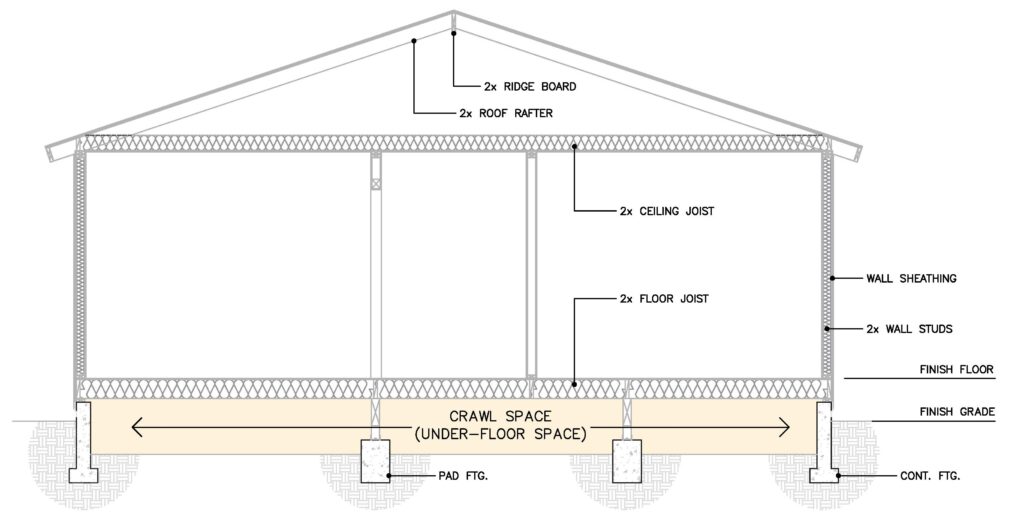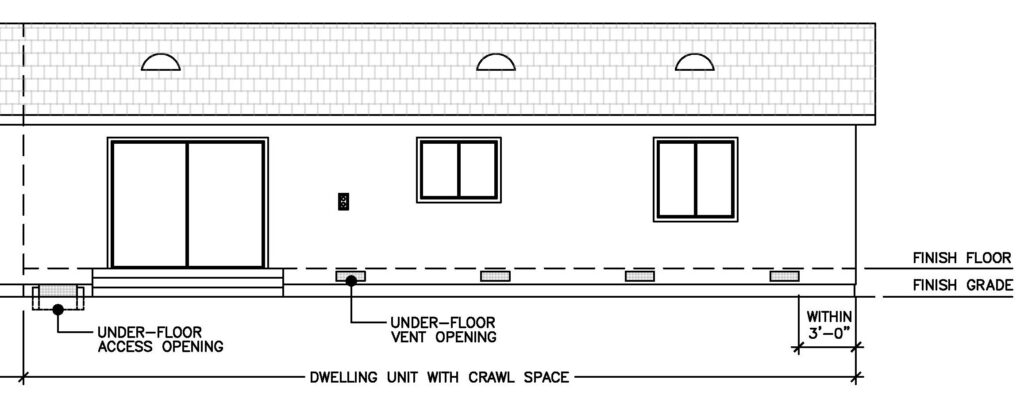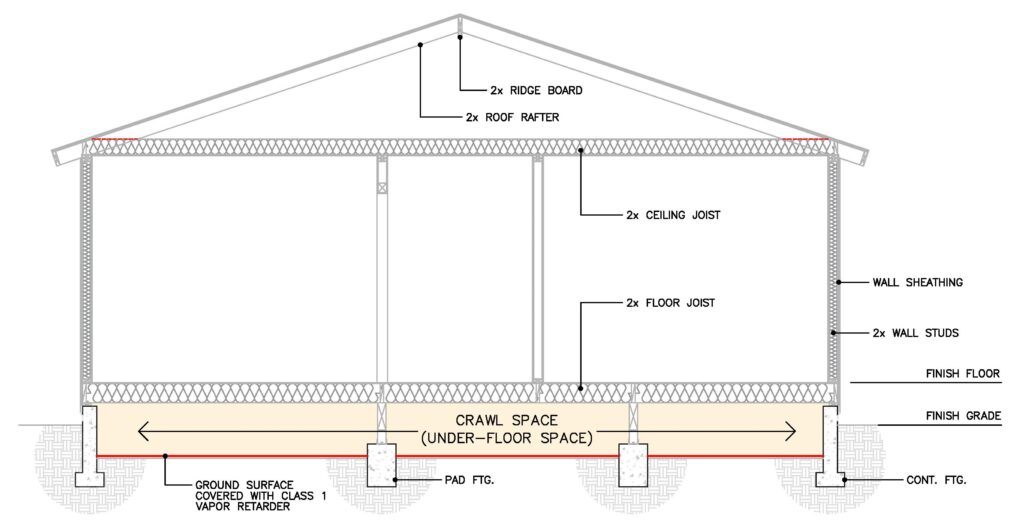
When it comes to residential construction there are typically two main types of foundations a house sits on. One is a concrete slab on grade foundation and the other is a raised floor foundation. These are the two main common types of foundations.
There are other types as well such as homes with basement foundations, caisson, piles, etc… however these are typically specific to the climate conditions and geographical location.
With that said I would like to explain the crawl space requirements for the common raised floor construction found in many residential dwellings.
The section regarding crawl space requirements is found in Section R408 of the International Residential Code (IRC). This section is titled “Under-Floor Space” because it establishes the code requirements for the space directly under the raised floor which commonly is referred to as a “crawl space”.
Due to geographical location and climate conditions condensation can occur within a crawl space possibly causing dry rot and other issues. To control condensation, natural ventilation of the crawl space is provided through foundation walls and other exterior wall openings to reduce the chances of dry rot and other issues.
In order for there to be proper ventilation, the code explains how to calculate the required size and number of openings to achieve a minimum level of condensation control. Lets take a look at how this is calculated.
Crawl Space Ventilation Calculation (R408.1)
Section R408.1 specifies that the crawl space (under-floor space), which is the area between the bottom of the floor joists and the earth under the building (not including the basement), must have ventilation openings through the foundation walls or exterior walls.

The determine the size and number required, the code gives the following calculations:
The minimum net area of ventilation opening must not be less than 1 square foot for each 150 square feet of under-floor space area. Here is an example:
A house has 1,500 square feet of crawl space area. The amount of ventilation required is 1,500/150 = 10 square feet. To convert to square inches multiply by 144. The 10 square feet X 144 square inches per square foot = 1,440 square inches.
Let’s say the size of 1 opening is 14″ x 6″. This provides 84 square inches of ventilation. Take 1,440 square inches and divide by 84 square inches = 17.14
Round up and the required number of ventilation openings to be provided shall be 18. (See explanation of section R408.2 below regarding net opening vs. gross)
Alternative Crawl Space Ventilation Calculation
There is another calculation allowed by code that would reduce the ventilation area substantially, but this would require the installation of a Class 1 vapor retarder material. When the Class 1 vapor retarder is used to cover the ground surface (earth) under the building, the following calculation can be used:
The minimum net area of ventilation opening must not be less than 1 square foot for each 1,500 square feet of under-floor space area. Here is an example:
Lets take the same example above to compare. A house has 1,500 square feet of crawl space area. The amount of ventilation required is 1,500/1,500 = 1 square feet. To convert to square inches multiply by 144. The 1 square feet X 144 square inches per square foot = 144 square inches.
Given the same size opening as above (14″ x 6″). This provides 84 square inches of ventilation. Take 144 square inches and divide by 84 square inches = 1.71
Round up and the required number of ventilation openings to be provided shall be 2. (See explanation of section R408.2 below regarding net opening vs. gross)
Only 2! That’s way less than the standard calculation above. But why is this?
Class 1 Vapor Retarder Alternative
When you install a vapor retarder material on the ground surface, it hinders if not prevents the flow of moisture from the earth, into the crawl space. This then drastically reduces if not eliminates the need for ventilation. This is why the second calculation provides such a drastic reduction of ventilation openings.

This option is still considered a vented crawl space since a small amount of moisture can still be present. The code language here only mentions placing the vapor retarder over the earth, not more than this. When we discuss unvented crawl space below, you will see additional language requiring the retarder to be lapped, taped, and sealed. We will talk more about this in the unvented crawl space section below.
One thing to keep in mind however is that when this method is used, the code requires the openings to be placed in such a way that provides cross ventilation. Basically they should be placed opposite of each other. The first method does not have such a requirement.
However the code does mention that in both scenarios there should be at least one opening located within 3 feet at each corner of the building.
Openings for Crawl Space Ventilation (R408.2)
Now lets talk about the ventilation openings themselves. The openings must be covered with a material that provides openings not exceeding 1/4 inch. The code provides a list of materials that comply. They are as follows:
- Perforated sheet metal plates not less than 0.070 inch thick.
- Expanded sheet metal plates not less than 0.047 inch thick.
- Cast-iron grill or grating.
- Extruded load-bearing brick vents.
- Hardware cloth of 0.035 inch wire or heavier.
- Corrosion-resistant wire mesh, with the least dimension being 1/8 inch thick.
The purpose of covering the openings is to keep animals and rodents from entering the crawl space.
Net Opening vs. Gross Opening
An important note to consider when you are calculating the required ventilation opening area is that since the openings are being covered, the area of the ventilation openings should account for the net free area of the covering material used instead of the gross area of the opening. When determining the minimum ventilation openings, you are calculating the net area. Therefore if the covering reduces the gross opening area by 50% then twice as many openings would be required.
For the purpose of simplicity, the calculation examples provided above do not account for any coverings, so depending on the amount reduced, the net area of the covering should be factored when calculating the required number of openings.
Unvented Crawl Spaces (R408.3)
Want to get rid of ventilation openings all together? The code defines this as Unvented Crawl Spaces. This means that when you design a crawl space with the conditions listed in Section R408.3, you do not need to provide any ventilation openings per Section R408.1 and R408.2. Therefore if an unvented crawl space is desired, one of the following conditions must be provided.
1. The exposed earth under the building must be covered with a Class I vapor retarder, similar to the above section, however in this case the joints shall overlap by 6 inches and must be sealed or taped. The vapor retarder edges must extend no less than 6 inches up the foundation stem wall and must be sealed and attached to the stem wall.

2. Anyone of the following must be provided:
– A continuous mechanical exhaust that is able to vent at a rate equal to 1 cubic feet per minute for each 50 square feet of crawl space area with an air pathway to the common area and where the perimeter walls are insulated per Section N1102.2.11.
– Same as above except that instead of mechanical exhaust, a conditioned air supply can be used.
– In existing structures, if the crawl space is used as a plenum that complies with Section M1601.5. This option is not allowed in new structures.
Although the first option does not require much more effort to install, the second option can be more challenging and costly when compared to the first one.
Crawl Space Access Opening (R408.4)
All crawl spaces must be provided with an access opening. This is to make sure continuing maintenance of the building can occur along with any inspections or repairs of plumbing, mechanical, or electrical runs within the crawl space.
Compliance can be achieved in one out of two ways. The first is by providing access through the floor with an opening no less than 18 inches by 24 inches in size. The second is through a perimeter foundation wall with an opening no less than 16 inches by 24 inches in size.
This section also goes on to say that the foundation wall openings shall not be located under a door. Also if mechanical equipment is located in the crawl space the minimum size opening and access requirements should comply with Section M1305.1.4 so that the opening and access is large enough to safely service the equipment.
Other Crawl Space Requirements
To read about other crawl space requirements such as the finish grade level of the crawl space and crawl spaces of buildings located in flood hazard zones, be sure to check out Section R408.6 and R408.7 of the International Residential Code (IRC).
.
* Reference Source – 2015 International Residential Code – [Buy on Amazon]
